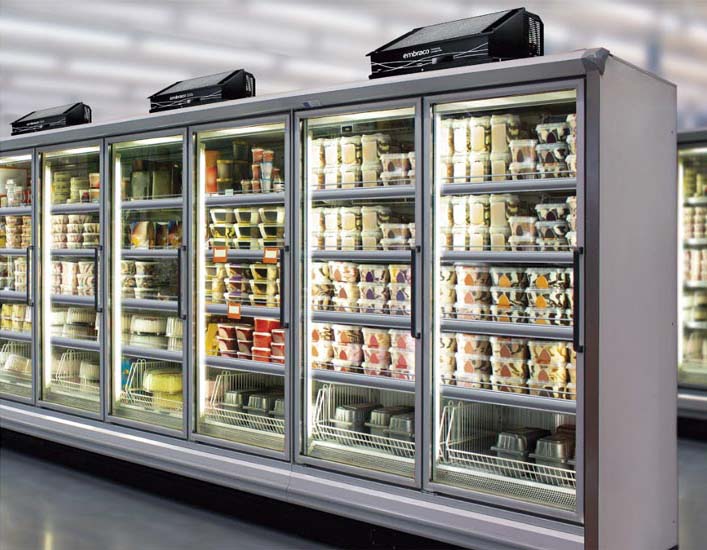Small-Format Stores Require Different Refrigeration Strategy
There is no one-size-fits-all approach for selecting equipment designed for smaller spaces

MANY OPTIONS: There are many refrigeration alternatives available for small-format stores, and there is no one-size-fits-all approach for selecting a refrigeration architecture. Courtesy, Emerson
When we think about supermarkets in the U.S., we typically think of sprawling suburban stores that utilize complex refrigeration rack systems, which can contain thousands of pounds of refrigerant. These ubiquitous large-format stores are often well over 100,000 square feet in size and offer shoppers virtually everything they need, from fresh produce to dog food to gardening equipment.
While these large grocery stores are not going away any time soon, there is a new trend taking hold in the marketplace: the small-format grocery store. These petite food retailers are usually under 40,000 square feet in size, and they are popping up in non-traditional locations such as urban areas and underserved communities. Refrigeration rack systems are too large for these small structures, so manufacturers are starting to offer new equipment that is designed to fit in these tight spaces.
The Tiny Trend in Retail
The global food retail industry has been trending toward smaller store footprints for several years, and there are many drivers leading retailers to embrace small-format grocery stores, said Andre Patenaude, director of solution integration – cold chain, Emerson.
“Retailers are tasked with providing optimum shopping experiences for their customers and tailoring their offerings to regional preferences,” he said. “Small-format stores, which can be located in much closer proximity to customer bases in urban areas and universities, are ideal for this type of personalized approach.”

GLOBAL TREND: The global food retail industry has been trending toward smaller store footprints for several years. Courtesy, Emerson
Trying to find real estate for a larger-footprint store in a high-density population center can also be a challenge, which is another reason why retailers are starting to look at smaller spaces, which typically range in size from 20,000 to 40,000 square feet, said Patenaude.
“This smaller size gives retailers more flexibility in selecting a store location, while minimizing the capital investment needed to open a new store,” he said. “In many ways, this trend is a win-win for retailers and customers — helping retailers get closer to their customers and providing more targeted regional offerings while lowering startup costs.”
Several major food retailers in the U.S. are already experimenting with the small-format concept, especially in densely populated urban areas, said Pedro Besen Soprana, who is the key account manager for the Embraco portfolio in North America at Nidec Global Appliance.
“In such regions, on-the-go shoppers tend to visit these stores more frequently, and small formats offer a faster and seamless shopping experience,” he said. “There has also been a significant growth of dollar stores, which are small format and usually offer groceries, so refrigeration equipment is needed there as well.”
Tecumseh is also seeing a small-format trend developing in the United States, as well as around the world, where urbanization is causing a shift in the way people shop for groceries, essentials, and other items, said Hiroshi Saito, director of global marketing at Tecumseh Products Company.
“Due to massive growth in e-commerce from places like Amazon and Wal-Mart and food delivery services like Blue Apron and Hello Fresh, grocery stores are shrinking their stock to items that are regularly bought,” he said. “There are also micro stores like Amazon Go, which are located in the city, where people can get in and out quickly for immediate essentials.”
Small Design
Small-format stores are not usually newly built; instead, they are often constructed in existing mixed-use spaces that weren’t initially designed to accommodate the heavy refrigeration equipment normally required for a food retail store, said Soprana. As a result, repurposing the space can be quite challenging and costly.
“Another issue is that in certain cases, the spaces are leased and some tenants (retailers) are skeptical about investing big dollars in traditional refrigeration equipment that can limit the flexibility of negotiating lease contract renewals,” he said.
Not surprisingly, space — or lack thereof — is also a big consideration in small-format stores. For example, in several mixed-use spaces, even the door clearances can restrict the type of equipment that can be installed, said Soprana.
“Some of these spaces are located under residential buildings, where the installation of remote racks or condensing units, which are normally assembled on store rooftops, are not practical,” he said. “So, self-contained cases — systems in which the condensing unit is integrated with the case — tend to be well-suited for small-format stores, since a machinery room and long piping lines are not required in this configuration. Self-contained units also provide store layout flexibility, because the unit is integrated into the refrigeration equipment, so it can be moved around very easily inside the store.”
Patenaude agreed, noting that inaccessibility to a facility’s rooftop, as well as no available space for a mechanical room, will often dictate which options a small-format store can consider. Fortunately, there are many refrigeration alternatives to the traditional, centralized approaches used in larger-format stores.
“These alternatives are often more flexible and typically combine a distributed refrigeration architecture for primary refrigeration needs, along with stand-alone cases that can be moved around the store to support seasonal and regional offerings,” he said. “These distributed approaches typically rely on indoor or outdoor condensing unit (OCU) architectures that allow the refrigeration equipment to be installed in closer proximity to display cases.”
One of the advantages of taking a decentralized approach in a small-format store is the ability to deploy a distributed controls architecture, said Patenaude.
“This allows individual refrigeration assets to be operated and controlled independently, and when used in tandem with a centralized building or facility management controller, provide communication to maintain centralized visibility to all assets — a hybrid approach that enables the best of both worlds,” he said. “Each individual controller is responsible for operating its respective asset independently. In the event the facility controller goes down, there’s little to no impact to individual assets.”
Available Refrigeration Options
As Patenaude noted, there are many refrigeration alternatives available for small-format stores, and he stresses that it is important to remember that there is no one-size-fits-all approach for selecting a refrigeration architecture.
“Retailers have a wide range of pain points and business criteria on which to base their individual decisions — such as environmental sustainability, system lifecycle costs, and servicing requirements,” he said. “Emerson supports, develops, and enables a variety of refrigeration solutions that can be utilized in most existing and emerging small-format architectures.”
To that end, Emerson offers a full complement of compression technologies, facility management controls and valves, outdoor condensing units — including its recently launched Copeland™ Digital Outdoor Refrigeration Unit, X-Line Series — and Copeland indoor modular solution.
“Not only are we committed to supporting the small-format retail industry with continual innovation, we are actively partnering with OEM and retail customers to help create high-value solutions for this growing sector,” said Katrina Krites, market and business development manager, food retail, cold chain at Emerson. “Our goal is to combine our refrigeration technology and component portfolios with design and domain expertise to provide fully integrated solutions that address a wide range of end user criteria.”
Tecumseh also offers a solution for small-format stores, with its IntelliCOOL Complete Refrigeration System (CRS).
“These small stores need energy savings, monetary savings and to maximize space, and the Tecumseh IntelliCOOL CRS solves all these problems by running on R-290 propane refrigerant and giving store owners the flexibility to move it wherever they need,” said Saito. “There is no piping, refrigerant charging, or installation needed by an experienced technician—all they need is to plug the system into an outlet. Furthermore, since the technology needed to cool the unit is drastically reduced, store owners are now able to keep more merchandise in their units.”
Embraco offers an array of compressors and condensing units, as well as pre-charged sealed units (also known as cassettes) that were designed to speed up the development cycle of self-contained cases, said Soprana.
“The cassettes are especially suited for small-format stores, given that they are factory-sealed modular systems,” he said. “This means there is no need for vacuuming, charging, or brazing in the field during the commissioning process. In case of maintenance, because of the modular concept, the cassette can be easily popped out of the case and replaced by a functional unit.”

GLOBSMALL SOLUTION: One of Embraco’s solutions for small-format stores, called the Plug n’ Cool, uses propane (R-290) as its refrigerant and features variable-speed compressor technology.
One of Embraco’s sealed units, called Plug n’ Cool, uses propane (R-290) as its refrigerant and features variable-speed compressor technology. Soprana noted that this unit is easy to install and maintain and can be repaired off-site, which avoids the disruption of sales when maintenance is needed.
“The self-contained architecture saves time, money, and real estate when compared to remote systems,” he said. “The configuration also brings the benefit of safety, because it uses a small charge of refrigerant and has a smaller risk of refrigerant leakage. In addition, in a self-contained configuration, each cooling unit works independently, so if there is a problem in one unit, the others provide redundancy and can keep the products refrigerated until the first is up and running again.”
Need to Know
Many self-contained units contain propane, which is a flammable hydrocarbon (HC) refrigerant that requires special attention from those installing or servicing this type of equipment. OEMs agree that before working on any system that contains an HC refrigerant, technicians should first obtain proper training in how to work safely with these refrigerants.
“Hydrocarbons can be flammable in a certain concentration,” said Denny Martin, who is the technical service specialist at Nidec Global Appliance, where he is responsible for technical support of Embraco brand aftermarket portfolio in North America. “For this reason, the work site must be monitored from start to finish for HC gas buildup by leaving a quality HC detector in the lowest part of the site, as the gas is heavier than air. An HC-specific ventilation fan can be used as well to ensure the gas will not accumulate in a low area. There are also recommended procedures for refrigerant removal, compressor replacement, tube connection, brazing, and more. Since they are very detailed, Embraco recommends all technicians to take a certified training before working in any system with natural refrigerants.”
It is also important for self-contained systems to be installed according to the OEM’s recommendations. This is usually pretty simple, said Martin, as generally speaking, the only requirements are a dedicated electrical circuit and an area with good ventilation.
“One other note is to protect the unit from moisture and debris and keep it away from everyday foot traffic as much as possible to keep the unit's condenser coil clean,” he said. “The manufacturer's recommendations for maintenance should also be followed closely to keep the unit working correctly and efficiently for a long time.”
Whether a unit contains natural refrigerants like CO2 or propane, or synthetic A1 or A2L blends, the food retail industry is transitioning from higher- to lower-GWP refrigerant options and small-format retailers are no exception. Given the growing number of refrigeration options that are available, many small-format retailers are overwhelmed and are looking to contractors to play a more consultative role, said Patenaude.
“This means that contractors will need to be well-versed in both the emerging refrigeration architectures and the properties of the lower-GWP refrigerants with which they will be working,” he said. “Contractors can work with manufacturers such as Emerson to help retailers develop equipment strategies that will allow them to transition to lower-GWP refrigerants today, while giving them a road map for achieving even lower GWP levels in the future.”







